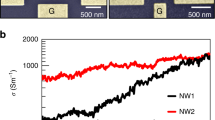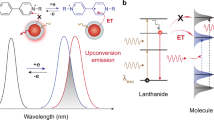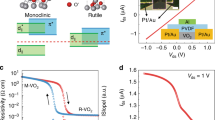Abstract
Nanotechnology has enabled the realization of hybrid devices and circuits in which nanoscale metal and semiconductor building blocks are woven together in a highly integrated fashion. In electronics, it is well known how the distinct material-dependent properties of metals and semiconductors can be combined to realize important functionalities, including transistors, memory and logic. We describe an optoelectronic device for which the geometrical properties of the constituent semiconductor and metallic nanostructures are tuned in conjunction with the materials properties to realize multiple functions in the same physical space. In particular, we demonstrate a photodetector in which the nanoscale electrical contacts have been designed to render the device ‘invisible’ over a broad frequency range. The structure belongs to a new class of devices that capitalize on the notion that nanostructures have a limited number of resonant, geometrically tunable optical modes whose hybridization and intermodal interference can be tailored in a myriad of useful ways.
This is a preview of subscription content, access via your institution
Access options
Subscribe to this journal
Receive 12 print issues and online access
$209.00 per year
only $17.42 per issue
Buy this article
- Purchase on Springer Link
- Instant access to full article PDF
Prices may be subject to local taxes which are calculated during checkout




Similar content being viewed by others
References
Schuller, J. A. et al. Plasmonics for extreme light concentration and manipulation. Nature Mater. 9, 193–204 (2010).
Brongersma, M. L., Hartman, J. W. & Atwater, H. A. Electromagnetic energy transfer and switching in nanoparticle chain arrays below the diffraction limit. Phys. Rev. B 62, 16356–16359 (2000).
Novotny, L. Effective wavelength scaling for optical antennas. Phys. Rev. Lett. 98, 266802 (2007).
Pendry, J. B., Schurig, D. & Smith, D. R. Controlling electromagnetic fields. Science 312, 1780–1782 (2006).
Shalaev, V. M. Optical negative-index metamaterials. Nature Photon. 1, 41–48 (2007).
Klein, M. W., Enkrich, C., Wegener, M. & Linden, S. Second-harmonic generation from magnetic metamaterials. Science 313, 502–504 (2006).
Fan, J. A. et al. Self-assembled plasmonic nanoparticle clusters. Science 328, 1135–1138 (2010).
Kekatpure, R. D., Barnard, E. S., Cai, W. & Brongersma, M. L. Phase-coupled plasmon-induced transparency. Phys. Rev. Lett. 104, 243902 (2010).
Liu, N. et al. Plasmonic analogue of electromagnetically induced transparency at the Drude damping limit. Nature Mater. 8, 758–762 (2009).
Manjavacas, A., Abajo, F. J. G. a. d. & Nordlander, P. Quantum plexcitonics: strongly interacting plasmons and excitons. Nano Lett. 11, 2318–2323 (2011).
Cao, L. Y. et al. Engineering light absorption in semiconductor nanowire devices. Nature Mater. 8, 643–647 (2009).
Schuller, J. A., Taubner, T. & Brongersma, M. L. Optical antenna thermal emitters. Nature Photon. 3, 658–661 (2009).
Muskens, O. L. et al. Large photonic strength of highly tunable resonant nanowire materials. Nano Lett. 9, 930–934 (2009).
Cao, L. Y., Fan, P. Y., Barnard, E. S., Brown, A. M. & Brongersma, M. L. Tuning the color of silicon nanostructures. Nano Lett. 10, 2649–2654 (2010).
Cao, L. Y. et al. Semiconductor nanowire optical antenna solar absorbers. Nano Lett. 10, 439–445 (2010).
Cao, L. Y., Park, J. S., Fan, P. Y., Clemens, B. & Brongersma, M. L. Resonant germanium nanoantenna photodetectors. Nano Lett. 10, 1229–1233 (2010).
Mie, G. Articles on the optical characteristics of turbid tubes, especially colloidal metal solutions. Ann. Phys. Berlin 25, 377–445 (1908).
Bohren, C. F. & Huffman, D. R. Absorption and Scattering of Light by Small Particles (Wiley, 1983).
Kreibig, U. & Vollmer, M. Optical Properties of Metal Clusters (Springer, 1995).
Alù, A. & Engheta, N. Achieving transparency with plasmonic and metamaterial coatings. Phys. Rev. E 72, 016623 (2005).
Alù, A. & Engheta, N. Cloaking a sensor. Phys. Rev. Lett. 102, 233901 (2009).
Silveirinha, M. G., Alù, A. & Engheta, N. Cloaking mechanism with antiphase plasmonic satellites. Phys. Rev. B 78, 205109 (2008).
Cai, W. S., Chettiar, U. K., Kildishev, A. V. & Shalaev, V. M. Optical cloaking with metamaterials. Nature Photon. 1, 224–227 (2007).
Valentine, J., Li, J., Zentgraf, T., Bartal, G. & Zhang, X. An optical cloak made of dielectrics. Nature Mater. 8, 568–571 (2009).
Leonhardt, U. Optical conformal mapping. Science 312, 1777–1780 (2006).
Cui, Y., Lauhon, L. J., Gudiksen, M. S., Wang, J. F. & Lieber, C. M. Diameter-controlled synthesis of single-crystal silicon nanowires. Appl. Phys. Lett. 78, 2214–2216 (2001).
Acknowledgements
The authors acknowledge support from a Multidisciplinary University Research Initiative grant (Air Force Office of Scientific Research, grant no. FA9550-10-1-0264), the Air Force Office of Scientific Research (AFOSR; grant no. FA9550-08-1-0220) and the Interconnect Focus Center, one of six research centres funded under the Focus Center Research Program (FCRP), a Semiconductor Research Corporation entity. P.F. would also like to acknowledge support from Stanford Graduate Fellowship.
Author information
Authors and Affiliations
Contributions
P.F., N.E. and M.L.B. conceived the experiments. P.F. and U.K.C. performed numerical simulations. L.C. performed silicon nanowire growth. P.F. performed sample fabrication and carried out all measurements. F.A. assisted with photocurrent measurement. P.F. and M.L.B. wrote the first draft of the manuscript. All authors discussed the results and contributed to the final version of the manuscript.
Corresponding author
Ethics declarations
Competing interests
The authors declare no competing financial interests.
Supplementary information
Supplementary information
Supplementary information (PDF 1493 kb)
Rights and permissions
About this article
Cite this article
Fan, P., Chettiar, U., Cao, L. et al. An invisible metal–semiconductor photodetector. Nature Photon 6, 380–385 (2012). https://doi.org/10.1038/nphoton.2012.108
Received:
Accepted:
Published:
Issue Date:
DOI: https://doi.org/10.1038/nphoton.2012.108
This article is cited by
-
Porous-spherical MnO2-Mn(OH)2/polypyrrole nanocomposite thin film photodetector in a wide optical range from UV to IR
Optical and Quantum Electronics (2023)
-
Optical and structural properties of 2D transition metal dichalcogenides semiconductor MoS2
Bulletin of Materials Science (2023)
-
Ultra-sensitive flexible Ga2O3 solar-blind photodetector array realized via ultra-thin absorbing medium
Nano Research (2022)
-
Development of CuO nanoporous material as a highly efficient optoelectronic device
Applied Physics A (2022)
-
Degeneracy of light scattering and absorption by a single nanowire
Scientific Reports (2021)



